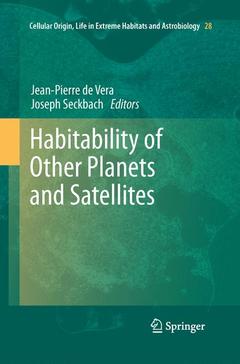Habitability of Other Planets and Satellites, Softcover reprint of the original 1st ed. 2013 Cellular Origin, Life in Extreme Habitats and Astrobiology Series, Vol. 28
Coordonnateurs : de Vera Jean-Pierre, Seckbach Joseph

Foreword.- Preface.- Introduction.- List of Authors and Their Addresses.- Acknowledgements.- Part 1: PARAMETERS FOR HABITABILITY, HABITABLE ZONES AND LIFE: ENERGY, LIQUID SOLVENT, INFORMATION.- The Habitable Zone: Basic Concepts.- Exoplanets: Criteria for Their Habitability and Possible Biospheres.- The Habitable Zone and The Generalized Greenhouse Effect.- The Influence of UV Radiation on Exoplanets’ Habitability.- Factors of Planetary Habitability.- Bio-relevant microscopic liquid subsurface water in planetary surfaces?.- Part 2: IMPACT CRATERS AND THE EVOLUTION OF LIFE.- Organic molecules in lunar ice: a window to the early evolution of life on Earth.- Part 3: FIELD STUDIES IN PLANETARY ANALOGS, SIMULATIONS AND SPACE EXPERIMENTS WITH RELEVANCE TO HABITABILITY.- Experimental simulation of possible origins of life (Conceptual and Practical Issues).- Simulation and measurement of extraterrestrial conditions for experiments on habitability with respect to Mars.- The Role of Terrestrial Analogs in the Exploration of The Habitability of Martian Evaporitic Environments.- Part 4: SEARCH FOR HABITABLE WORLDS IN THE SOLAR SYSTEM AND BEYOND.- Microbial scale habitability on Mars.- Interior and surface dynamics of terrestrial bodies and their implications for the habitability.- Exoplanets and habitability.- Part 5: ALTERNATIVES TO EARTH-LIKE LIFE.- Extremophiles on Alien Worlds: What Types of Organismic Adaptations are Feasible on Other Planetary Bodies.- Brown Dwarfs and Black Smokers. The Potential for Photosynthesis using Radiation from Low-Temperature Black Bodies.- Part 6: APPLICATION OF EXISTING TECHNOLOGIES FOR THE DETECTION OF HABITABLE PLANETS AND THE SEARCH FOR LIFE.- Detection of Habitable Planets and The Search for Life.- Raman Spectral Signatures in the Biogeological Record: An Astrobiological Challenge.- Application of Raman Spectroscopy as In Situ Technology for the Search for Life.- Part 7:FUTURE SPACE MISSIONS FOR LIFE DETECTION.- Habitability on Kepler worlds: Are Moons Relevant?.- Clean In-Situ Subsurface Exploration of Icy Environments in the Solar System.- Part 8: SUMMARY AND CONCLUSIONS.- Theoretically possible habitable Worlds – but soon will we get answers by observations?.- Subject Index.- Author Index.
Date de parution : 08-2015
Ouvrage de 419 p.
15.5x23.5 cm
Date de parution : 08-2013
Ouvrage de 419 p.
15.5x23.5 cm
Thèmes de Habitability of Other Planets and Satellites :
Mots-clés :
Astrobiology; Biosignatures; Exo-planets; Habitability; Solar System



